Geophysical Assessment of Seawater Intrusion into Coastal Aquifers of Bela Plain, Pakistan
Abstract
1. Introduction
2. Study Area and Hydrology
3. Materials and Methods
3.1. VES Survey
3.2. Dar-Zarrouk Parameters
3.3. Geochemical Method
4. Results
4.1. Interpretation of Resistivity Data
4.2. Transverse Resistance
4.3. Longitudinal Conductance
4.4. Longitudinal Resistivity
4.5. Physicochemical Analysis
5. Discussion
6. Conclusions
Author Contributions
Funding
Acknowledgments
Conflicts of Interest
References
- Hasan, M.; Shang, Y.; Akhter, G.; Jin, W. Application of VES and ERT for delineation of fresh-saline interface in alluvial aquifers of Lower Bari Doab, Pakistan. J. Appl. Geophys. 2019, 164, 200–213. [Google Scholar] [CrossRef]
- El Baba, M.; Kayastha, P.; Huysmans, M.; De Smedt, F. Evaluation of the Groundwater Quality Using the Water Quality Index and Geostatistical Analysis in the Dier al-Balah Governorate, Gaza Strip, Palestine. Water 2020, 12, 262. [Google Scholar] [CrossRef]
- Carol, E.; Kruse, E.; Mas-Pla, J. Hydrochemical and isotopical evidence of ground water salinization processes on the coastal plain of Samborombón Bay, Argentina. J. Hydrol. 2009, 365, 335–345. [Google Scholar] [CrossRef]
- Najib, S.; Fadili, A.; Mehdi, K.; Riss, J.; Makan, A. Contribution of hydrochemical and geoelectrical approaches to investigate salinization process and seawater intrusion in the coastal aquifers of Chaouia. Morocco. J. Contam. Hydrol. 2017, 198, 24–36. [Google Scholar] [CrossRef]
- Adepelumi, A.A.; Ako, B.D.; Ajayi, T.R.; Afolabi, O.; Omotoso, E.J. Delineation of saltwater intrusion into the freshwater aquifer of Lekki Peninsula, Lagos, Nigeria. Environ. Geol. 2009, 56, 927–933. [Google Scholar] [CrossRef]
- Shammas, M.I.; Jacks, G. Seawater intrusion in the Salalah plain aquifer, Oman. Environ. Geol. 2007, 53, 575–587. [Google Scholar] [CrossRef]
- Cimino, A.; Cosentino, C.; Oieni, A.; Tranchina, L. A geophysical and geochemical approach for seawater intrusion assessment in the Acquedolci coastal aquifer (Northern Sicily). Environ. Geol. 2008, 55, 1473–1482. [Google Scholar] [CrossRef]
- Alfarrah, N.; Walraevens, K. Groundwater overexploitation and seawater intrusion in coastal areas of arid and semi-arid regions. Water 2018, 10, 143. [Google Scholar] [CrossRef]
- Vann, S.; Puttiwongrak, A.; Suteerasak, T.; Koedsin, W. Delineation of Seawater Intrusion Using Geo-Electrical Survey in a Coastal Aquifer of Kamala Beach, Phuket, Thailand. Water 2020, 12, 506. [Google Scholar] [CrossRef]
- Barlow, P.M.; Reichard, E.G. Saltwater intrusion in coastal regions of North America. Hydrogeol. J. 2010, 18, 247–260. [Google Scholar] [CrossRef]
- Hasan, M.; Shang, Y.; Akhter, G.; Khan, M. Geophysical Investigation of Fresh-Saline Water Interface: A Case Study from South Punjab, Pakistan. Groundwater 2017, 55, 841–856. [Google Scholar] [CrossRef] [PubMed]
- Hasan, M.; Shang, Y.; Akhter, G.; Jin, W. Delineation of Saline-Water Intrusion Using Surface Geoelectrical Method in Jahanian Area, Pakistan. Water 2018, 10, 1548. [Google Scholar] [CrossRef]
- Costall, A.; Harris, B.; Pigois, J.P. Electrical Resistivity Imaging and the Saline Water Interface in High-Quality Coastal Aquifers. Surv. Geophys. 2018, 39, 753–816. [Google Scholar] [CrossRef]
- Goebel, M.; Pidlisecky, A.; Knight, R. Resistivity imaging reveals complex pattern of saltwater intrusion along Monterey coast. J. Hydrol. 2017, 551, 746–755. [Google Scholar] [CrossRef]
- Khublaryan, M.G.; Frolov, A.P.; Yushmanov, I.O. Seawater intrusion into coastal aquifers. Water Resour. 2008, 35, 274–286. [Google Scholar] [CrossRef]
- Kouzana, L.; Benassi, R.; Ben Mammou, A.; Sfar Felfoul, M. Geophysical and hydrochemical study of the seawater intrusion in Mediterranean semiarid zones. Case of the Korba coastal aquifer (Cap-Bon, Tunisia). J. Afr. Earth Sci. 2010, 58, 242–254. [Google Scholar] [CrossRef]
- Hasan, M.; Shang, Y.; Akhter, G.; Jin, W.J. Geophysical Assessment of Groundwater Potential: A Case Study from Mian Channu Area, Pakistan. Groundwater 2017, 56, 783–796. [Google Scholar] [CrossRef]
- Hasan, M.; Shang, Y.; Metwaly, M.; Jin, W.J.; Khan, M.; Gao, Q. Assessment of Groundwater Resources in Coastal Areas of Pakistan for Sustainable Water Quality Management using Joint Geophysical and Geochemical Approach: A Case Study. Sustainability 2020, 12, 9730. [Google Scholar] [CrossRef]
- Al Farajat, M. Characterization of a coastal aquifer basin using gravity and resistivity methods: A case study from Aqaba in Jordan. Acta Geophys. 2009, 57, 454–475. [Google Scholar] [CrossRef]
- Abdalla, O.A.E.; Ali, M.; Al-Higgi, K.; Al-Zidi, H.; El-Hussain, I.; Al-Hinai, S. Rate of seawater intrusion estimated by geophysical methods in an arid area: Al Khabourah, Oman. Hydrogeol. J. 2010, 18, 1437–1445. [Google Scholar] [CrossRef]
- Akpan, A.E.; Ugbaja, A.N.; George, N.J. Integrated geophysical, geochemical and hydrogeological investigation of shallow groundwater resources in parts of the Ikom-Mamfe Embayment and the adjoining areas in Cross River State, Nigeria. Environ. Earth Sci. 2013, 70, 1435–1456. [Google Scholar] [CrossRef]
- Niculescu, B.M.; Andrei, G. Using Vertical Electrical Soundings to Characterize Seawater Intrusions in the Southern Area of Romanian Black Sea Coastline. Acta Geophys. 2019, 67, 1845–1863. [Google Scholar] [CrossRef]
- Gurunadha Rao, V.V.S.; Tamma Rao, G.; Surinaidu, L.; Rajesh, R.; Mahesh, J. Geophysical and geochemical approach for seawater intrusion assessment in the Godavari Delta basin, A.P., India. Water Air Soil Pollut. 2011, 217, 503–514. [Google Scholar] [CrossRef] [PubMed]
- George, N.J.; Obianwu, V.I.; Obot, I.B. Estimation of groundwater reserve in unconfined frequently exploited depth of aquifer using a combined surficial geophysical and laboratory techniques in The Niger Delta, South–South, Nigeria. Pelagia Research Library (USA) AASRFC. Adv. Appl. Sci. Res. 2011, 2, 163–177. [Google Scholar]
- Singh, U.K.; Das, R.K.; Hodlur, G.K. Significance of Dar-Zarrouk parameters in the exploration of quality affected coastal aquifer systems. Environ. Geol. 2004, 45, 696–702. [Google Scholar] [CrossRef]
- Water and Power Development Authority, Pakistan (WAPDA). Annual report of river and climatological data of Pakistan, river discharge, sediment and quality data. In Prepared by Surface Water Hydrology Project, WASID; WAPDA: Lahore, Pakistan, 1973. [Google Scholar]
- Water and Power Development Authority, Pakistan (WAPDA). Annual Reports 1988–89; WAPDA: Lahore, Pakistan, 1989; pp. 21–98.
- McNeill, J.D. Electromagnetic Terrain Conductivity Measurements at Low Induction Numbers; Technical Note TN-6; Geonics, Ltd.: Misissauga, ON, Canada, 1980. [Google Scholar]
- Sherif, M.; El Mahmoudi, A.; Garamoon, H.; Kacimov, A.; Akram, S.; Ebraheem, A.; Shetty, A. Geoelectrical and hydrogeochemical studies for delineating seawater intrusion in the outlet of Wadi Ham, UAE. Environ. Geol. 2006, 49, 536–551. [Google Scholar] [CrossRef]
- Khalil, M.I.; Didar-Ul Islam, S.M.; Uddin, M.J.; Majumder, R.K. Coastal Groundwater Aquifer Characterization from Geoelectrical Measurements—A Case Study at Kalapara, Patuakhali, Bangladesh. J. Appl. Geol. 2020, 5, 1–12. [Google Scholar] [CrossRef]
- Himia, M.; Tapias, J.; Benabdelouahab, S.; Salhi, A.; Rivero, L.; Elgettafi, M.; Mandour, A.E.; Stitou, J.; Casas, A. Geophysical characterization of saltwater intrusion in a coastal aquifer: The case of Martil-Alila plain (North Morocco). J. Afr. Earth Sci. 2017, 126, 136–147. [Google Scholar] [CrossRef]
- Eissa, M.S.; Mahmoud, H.H.; Orfan, S.S. Geophysical and geochemical studies to delineate seawater intrusion in Bagoush Area, Northwestern coast, Egypt. Afr. Earth Sci. 2016, 121, 365–381. [Google Scholar] [CrossRef]
- Zarroca, M.; Bach, J.; Linares, R.; Pellicer, X.M. Electrical methods (VES and ERT) for identifying, mapping and monitoring different saline domains in a coastal plain region (Alt Empord_a, Northern Spain). J. Hydrol. 2011, 409, 407–422. [Google Scholar] [CrossRef]
- Gao, Q.; Shang, Y.; Hasan, M.; Jin, W.; Yang, P. Evaluation of a Weathered Rock Aquifer Using ERT Method in South Guangdong, China. Water 2018, 10, 293. [Google Scholar] [CrossRef]
- Telford, W.M.; Geldart, L.P.; Sheriff, R.E. Applied Geophysics; Cambridge University Press: Cambridge, UK, 1990; p. 770. [Google Scholar]
- Loke, M.H.; Acworth, I.; Dahlin, T. A comparison of smooth and blocky inversion method in 2D electrical tomography surveys. Explor. Geophys. 2003, 34, 182–187. [Google Scholar] [CrossRef]
- IpI2Winv.2.1Usersguide. In Computer Software User Guide Catalog; Moscow State University, Geological Faculty, Department of Geophysics and GEOSCAN-M Ltd.: Moscow, Russia, 2001; p. 25.
- Batayneh, A.T. The estimation and significance of Dar-Zarrouk parameters in the exploration of quality affecting the Gulf of Aqaba coastal aquifer systems. J. Coast. Conserv. 2013, 17, 623. [Google Scholar] [CrossRef]
- Hasan, M.; Shang, Y.; Akhter, G.; Jin, W.J. Delineation of contaminated aquifers using integrated geophysical methods in Northeast Punjab, Pakistan. Environ. Monit. Assess. 2019, 192, 12. [Google Scholar] [CrossRef]
- Ehirim, C.N.; Nwankwo, C.N. Evaluation of aquifer characteristics and groundwater quality using geoelectric method in Choba, Port Harcourt. Arch. Appl. Sci. Res. 2010, 2, 396–403. [Google Scholar]
- Henriet, J.P. Direct application of the Dar-Zarrouk parameters in ground water surveys. Geophys. Prospect. 1976, 24, 344–353. [Google Scholar] [CrossRef]
- Kelly, W.E.; Reiter, P.F. Influence of anisotropy on relation between electrical and hydraulic properties. J. Hydrol. 1984, 74, 311–321. [Google Scholar] [CrossRef]
- WHO (World Health Organization). Guidelines for Drinking-Water Quality. Recommendations Incorporating 1ST and 2nd Addenda, 3rd ed.; World Health Organization: Geneva, Switzerland, 2008; Volume 1. [Google Scholar]
- APHA (American Public Health Association). Standard Methods for the Examination of Water and Wastewater; American Public Health Association: Washington, DC, USA, 2000. [Google Scholar]

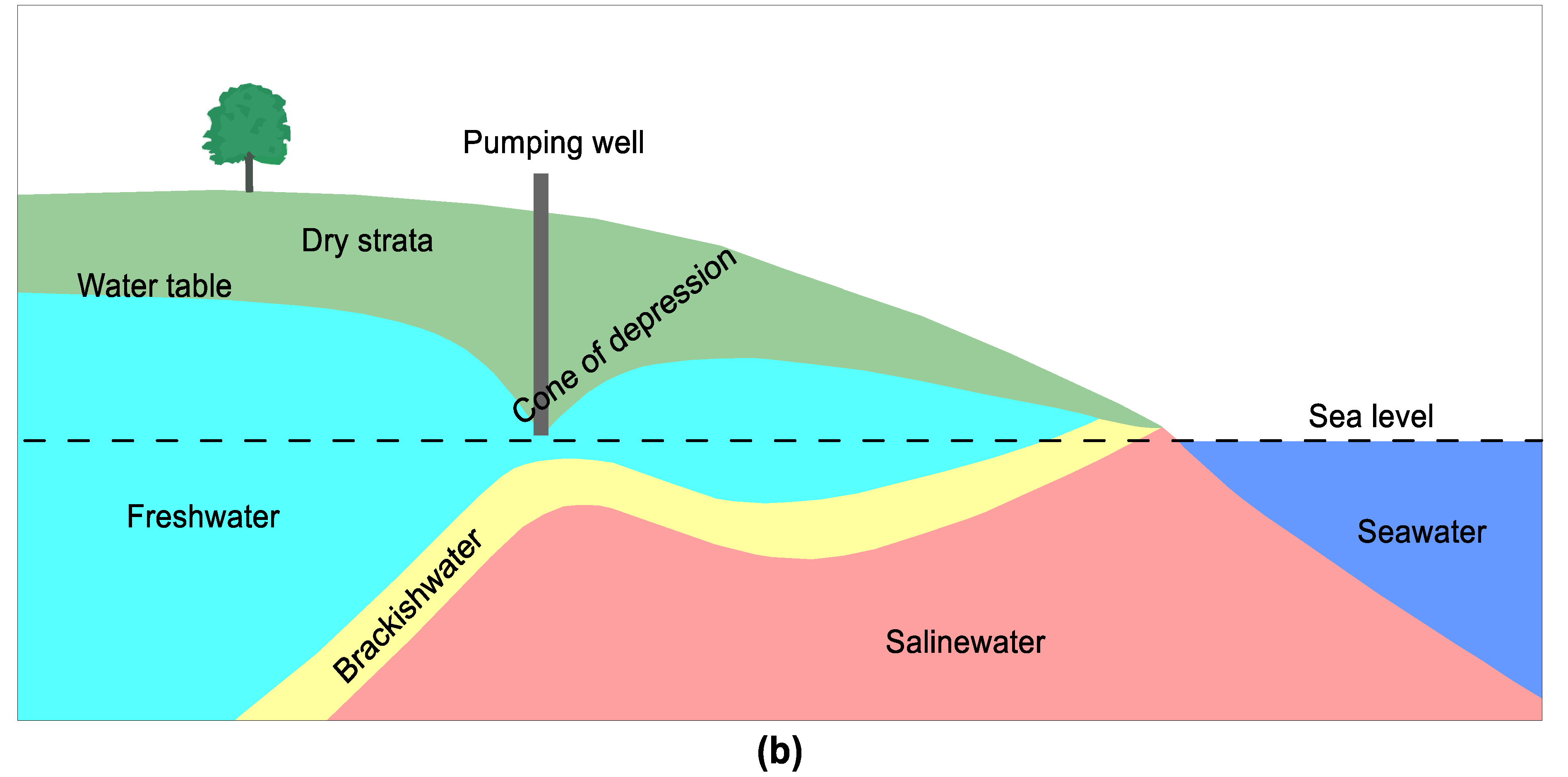
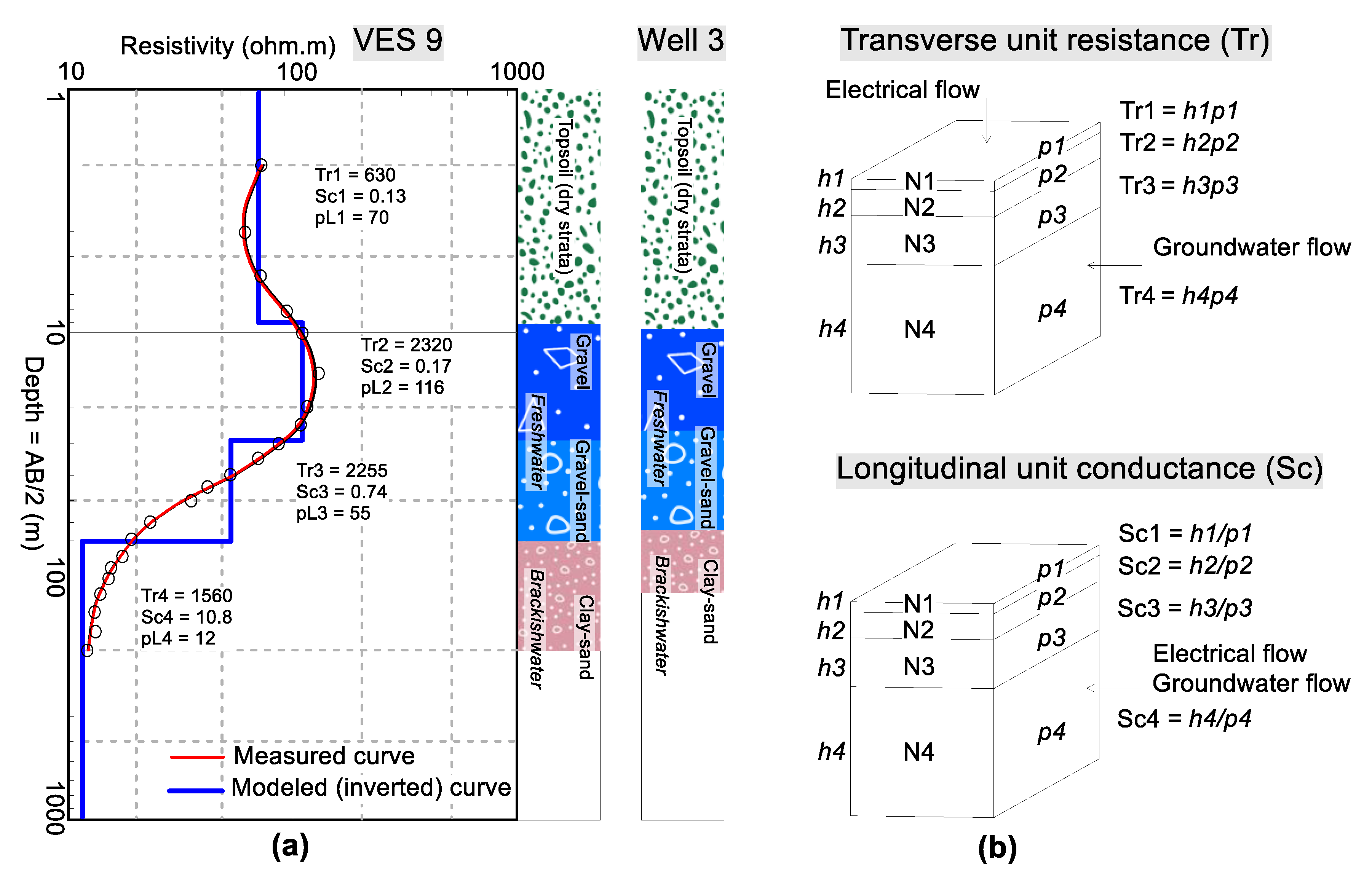
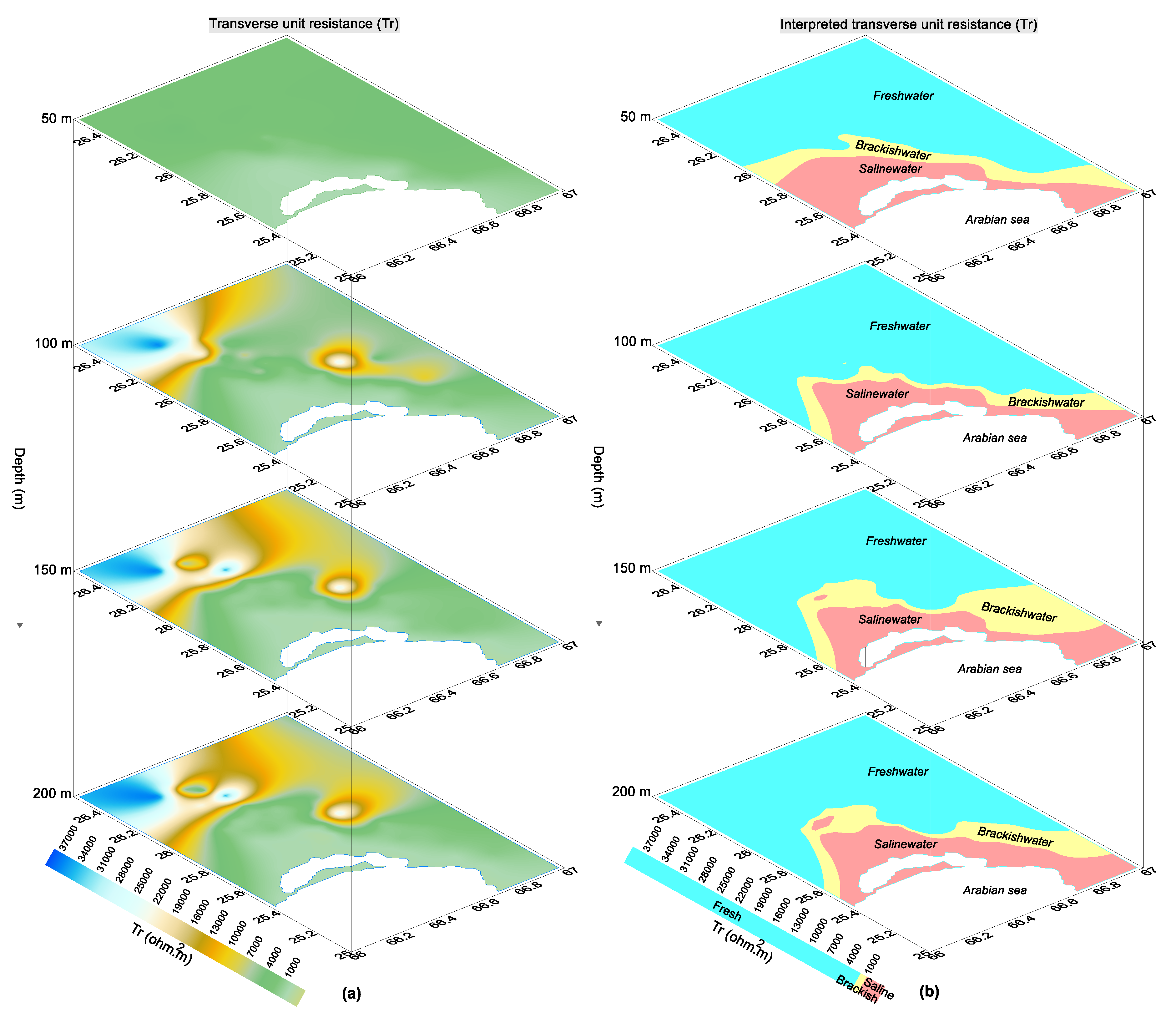
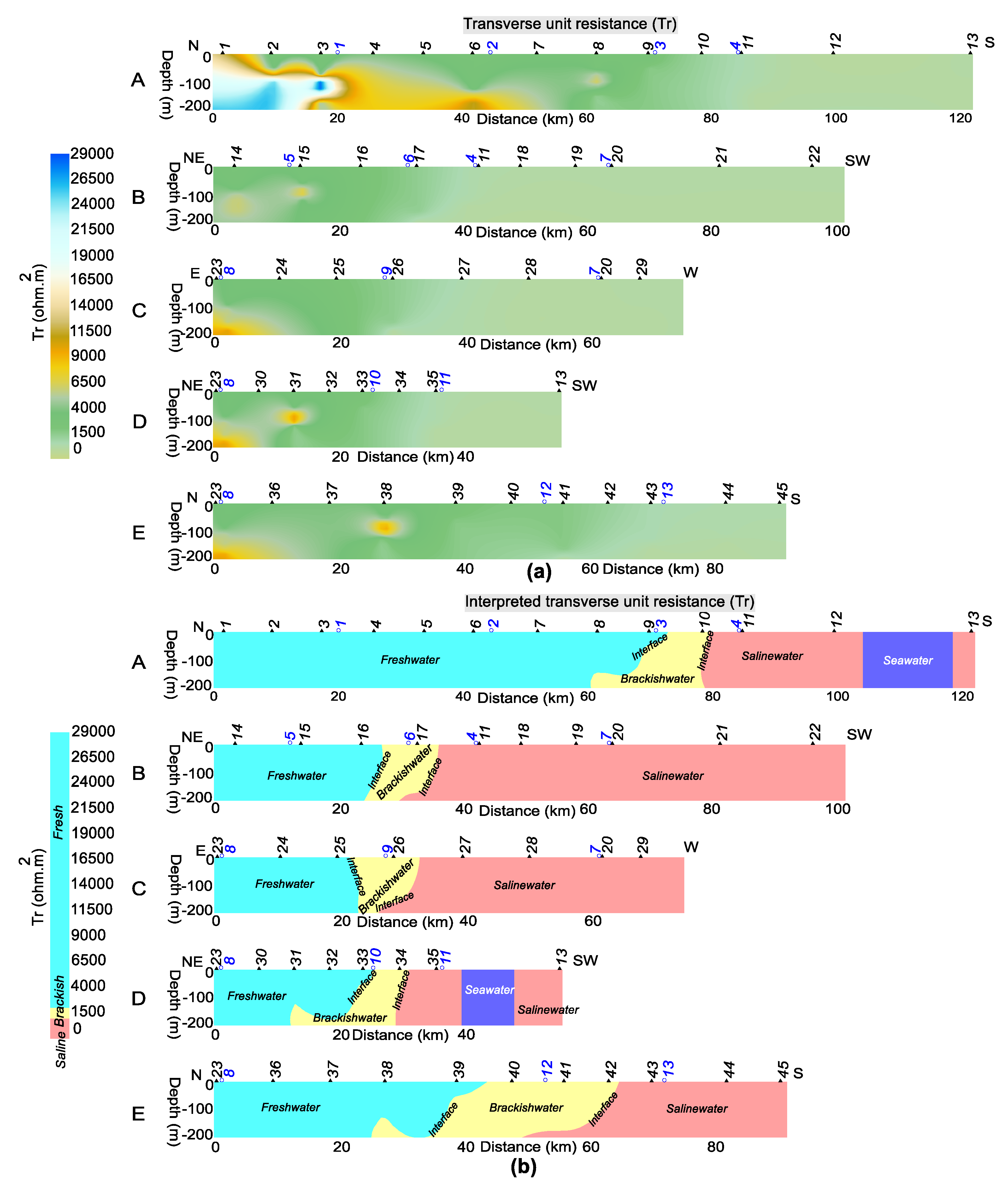
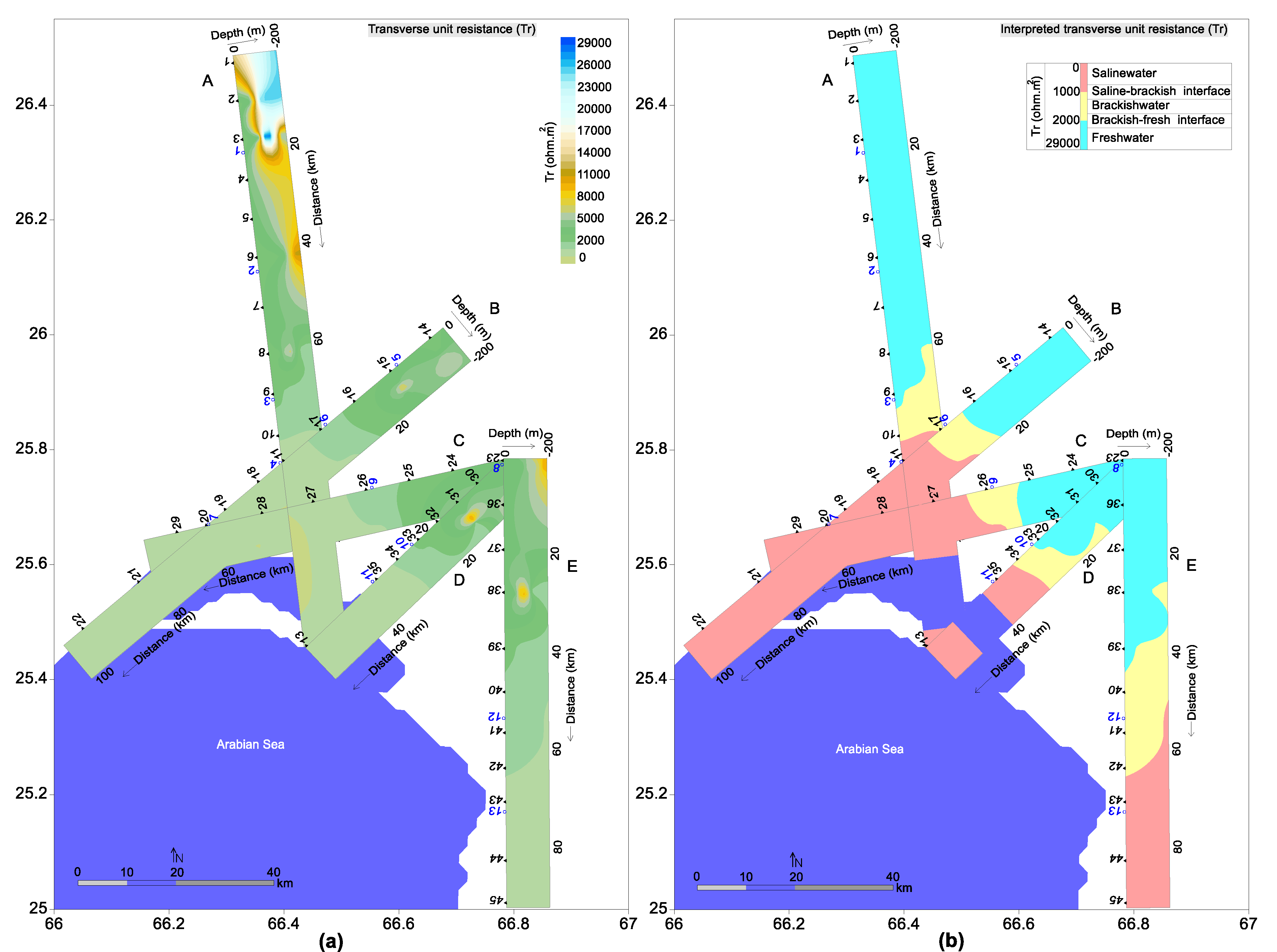
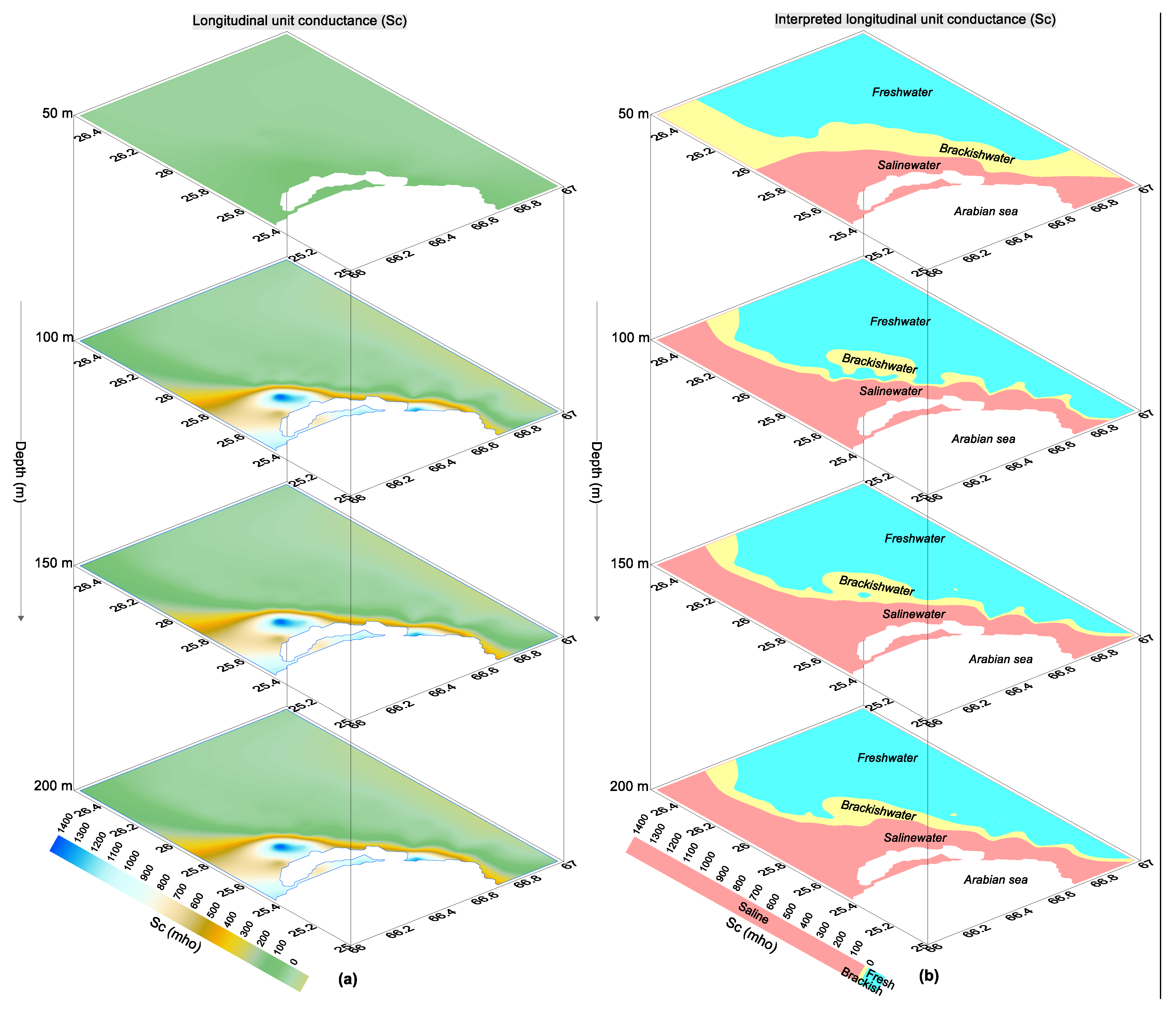
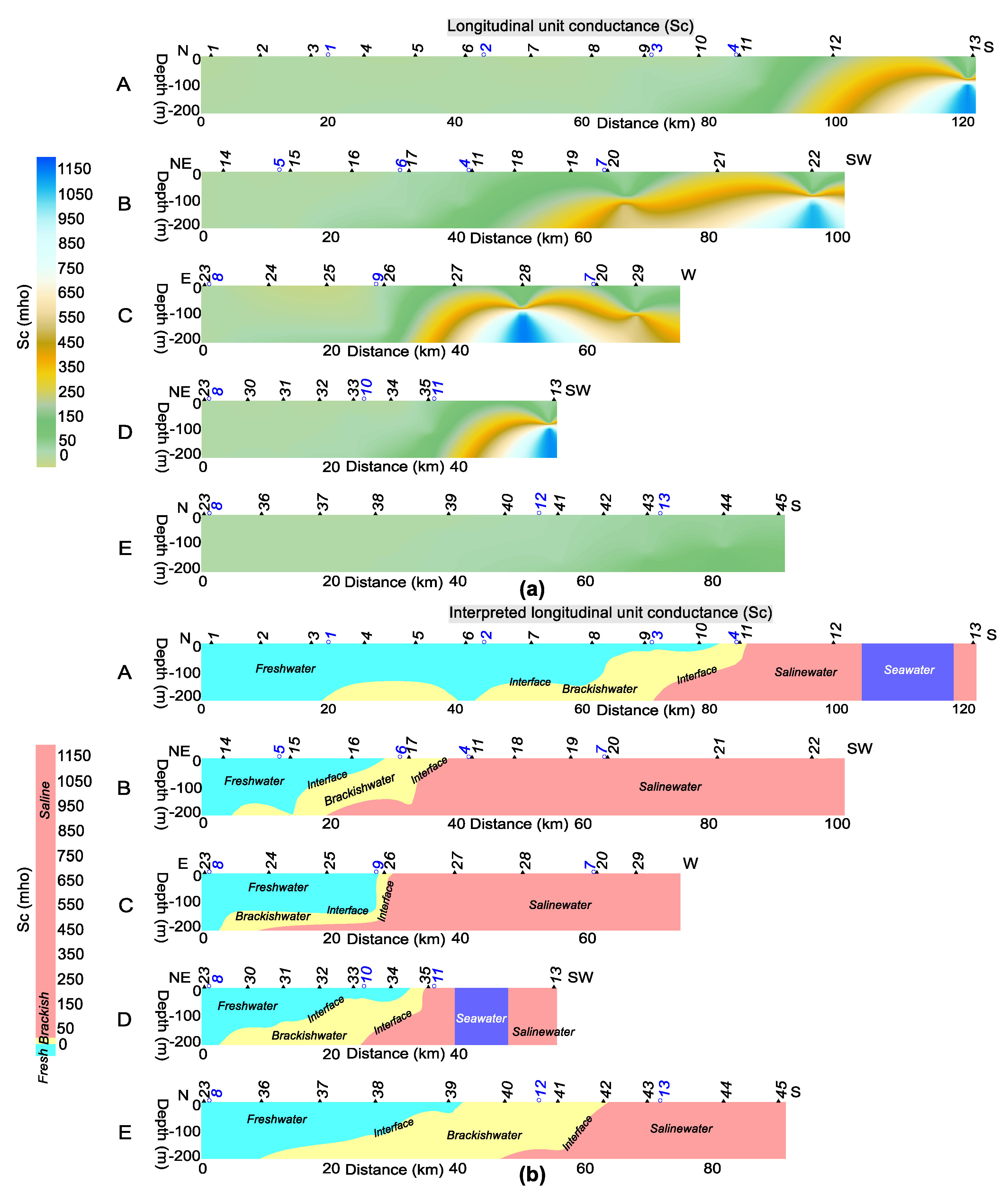
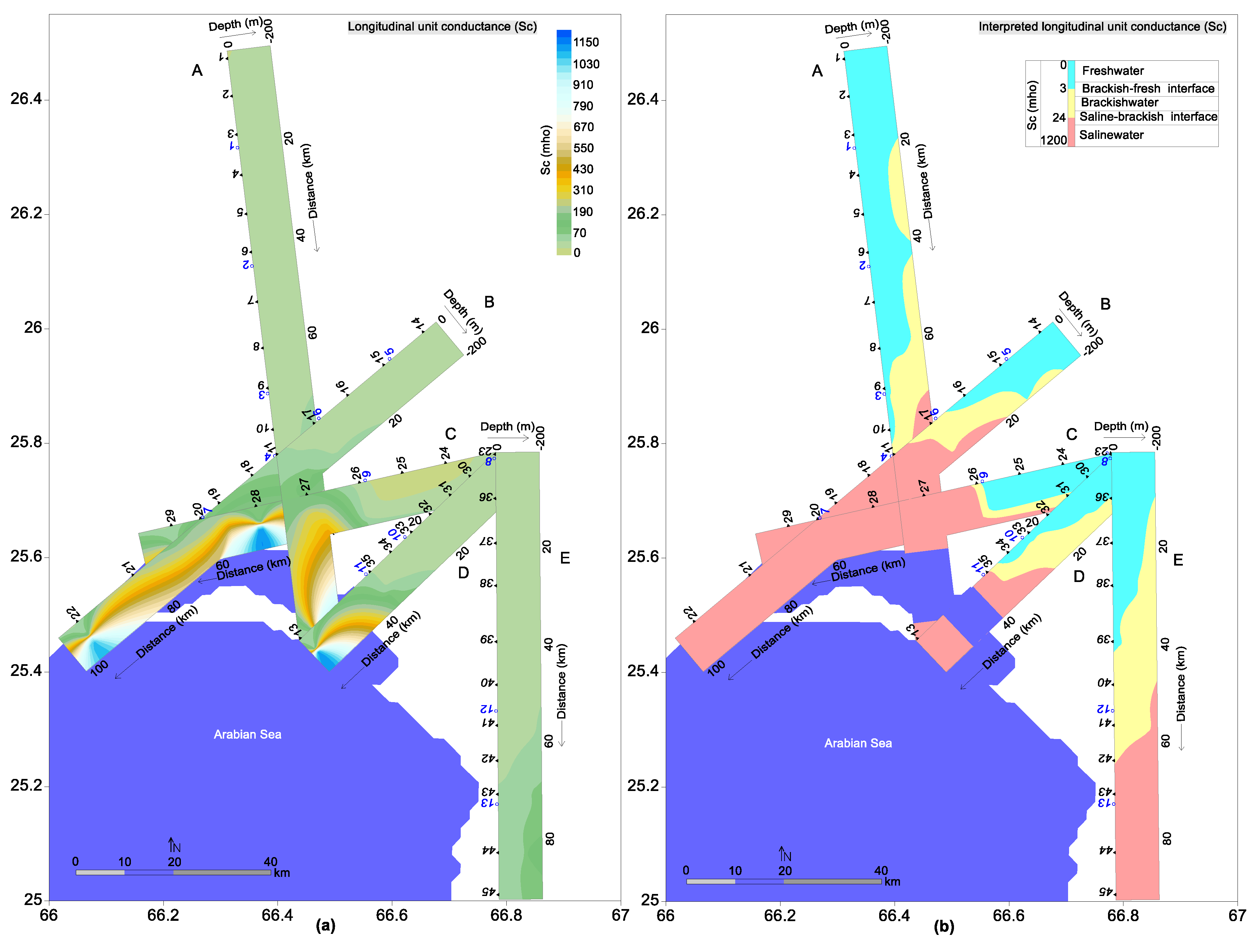
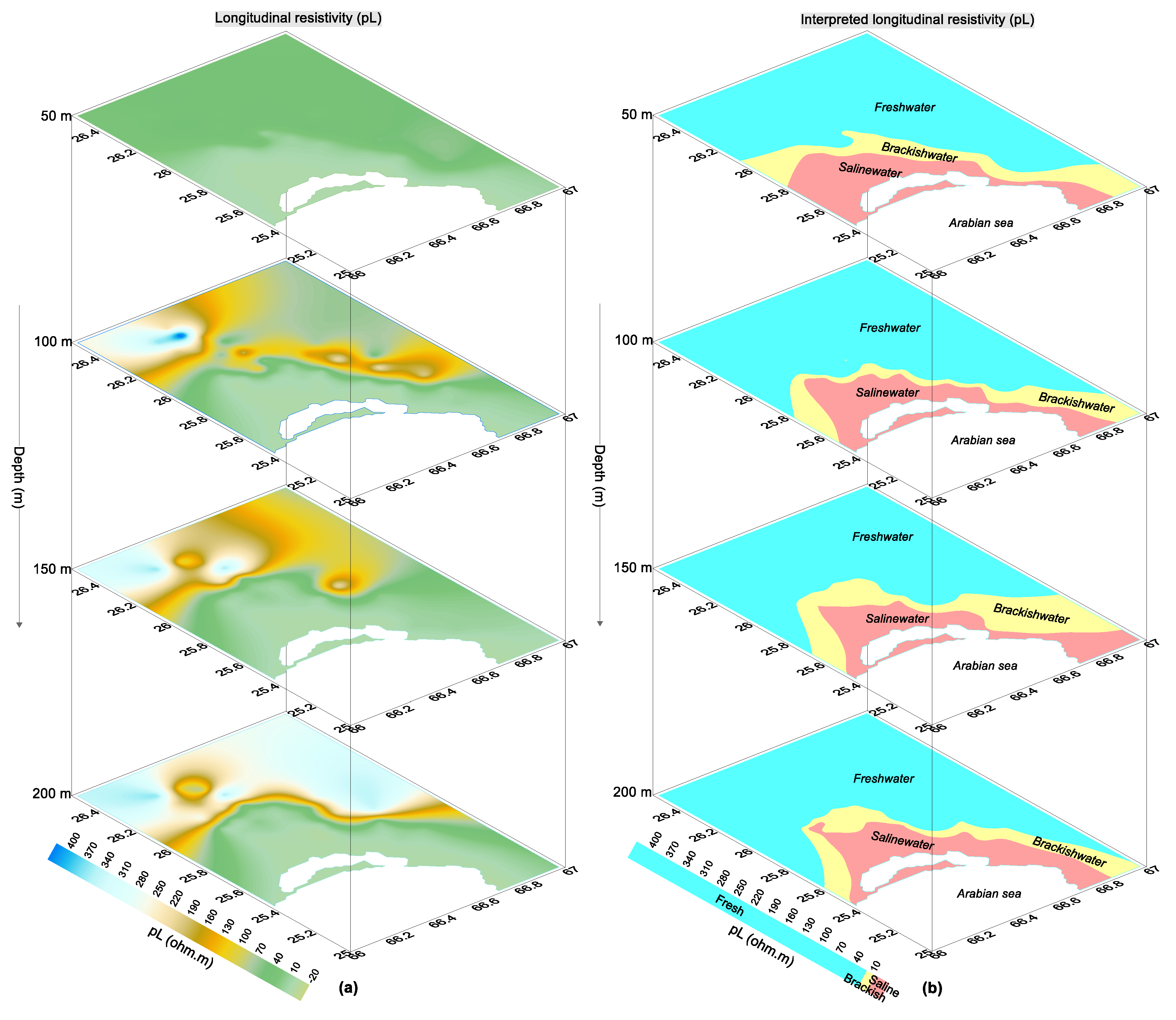
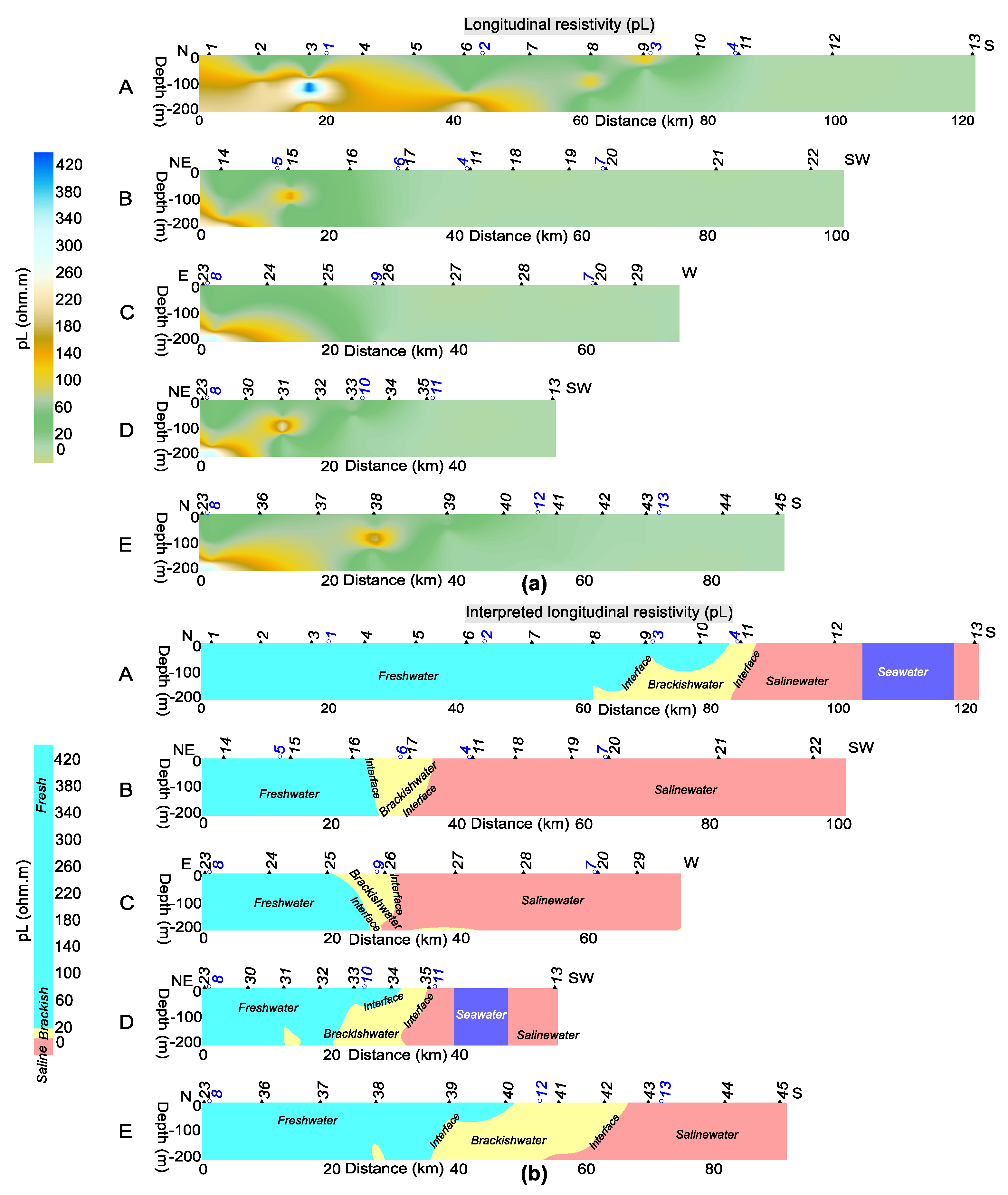
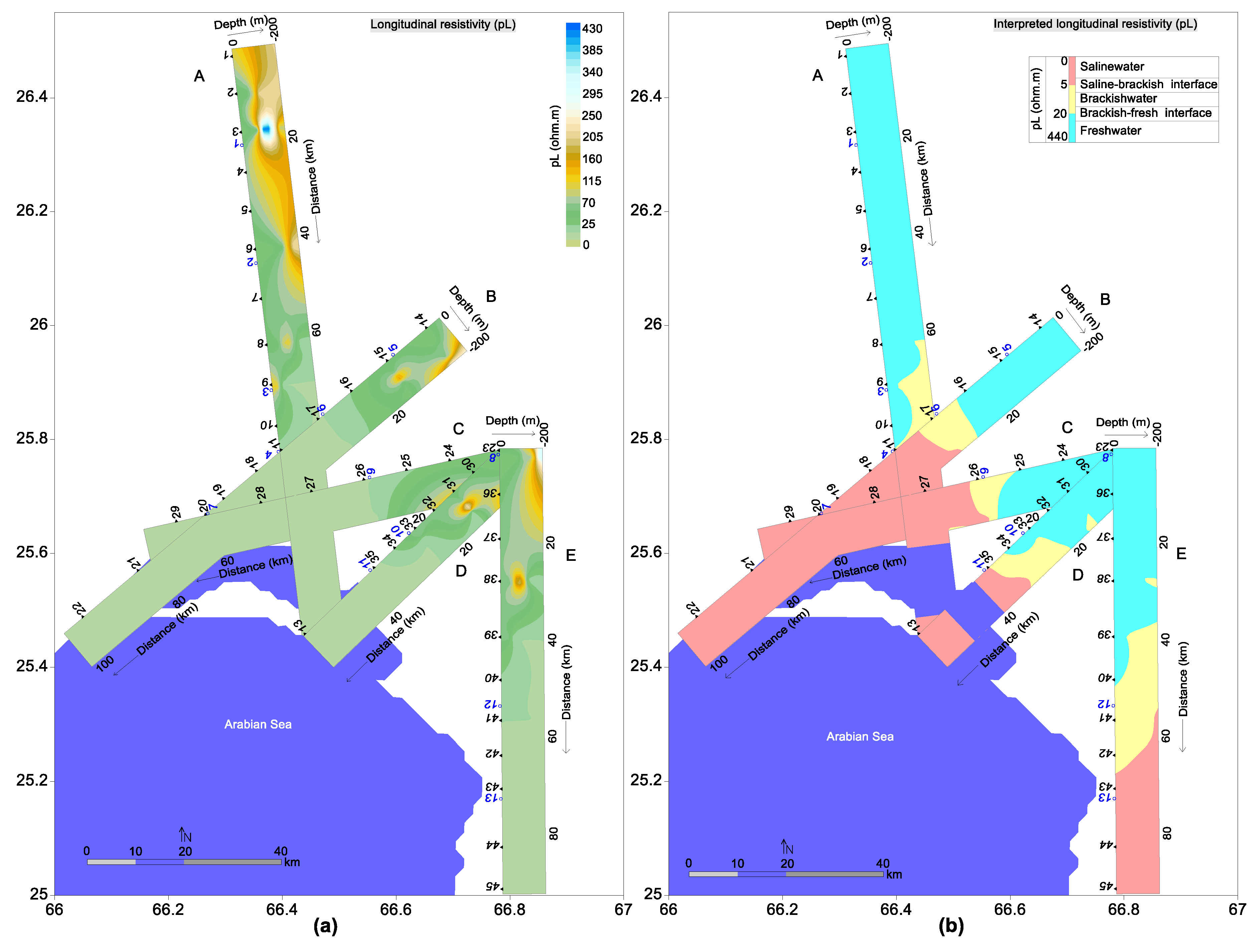
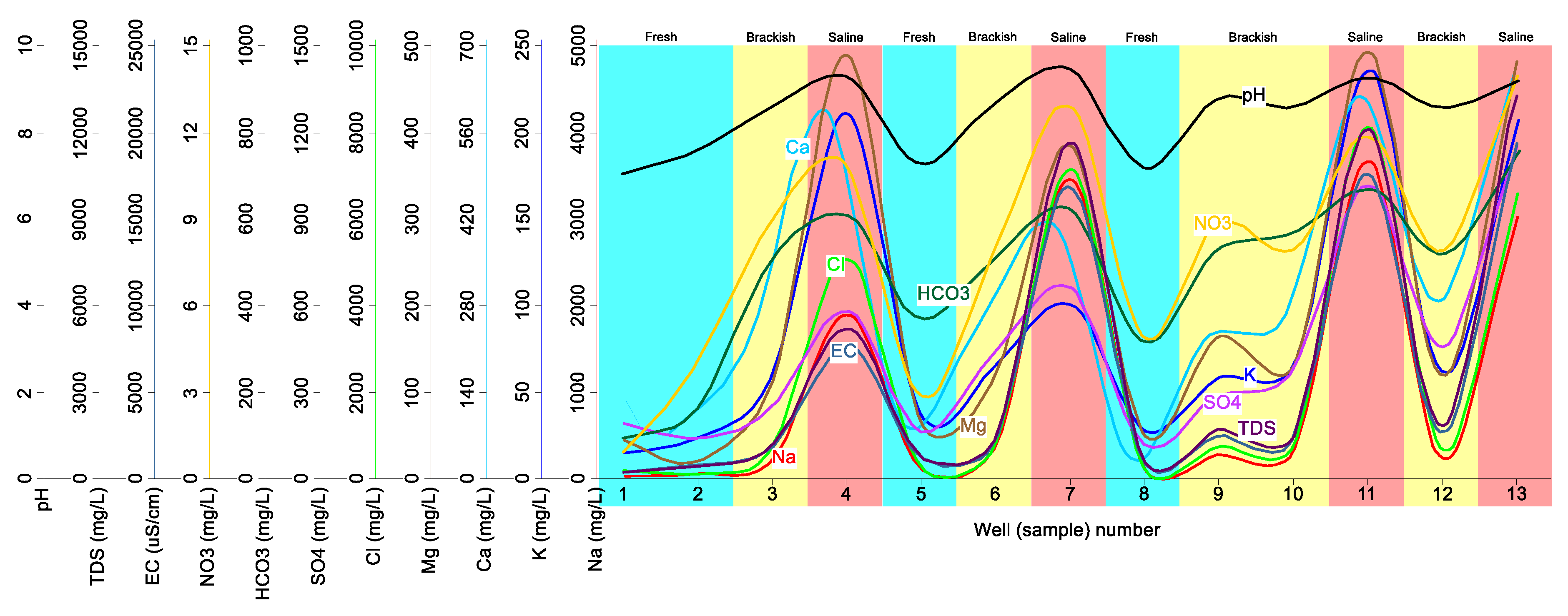

| Subsurface Resistivity (Ωm) | Lithology Type | Overlapping | |||
|---|---|---|---|---|---|
| Resistivity | Lithology | Aquifer | |||
| >35 (above water table) | Topsoil cover (dry strata) | - | - | - | |
| <7 (below water table) | Clay (saline water) | 4–7 | Clay and Clay-sand | Saline-brackish | |
| 4–24 (below water table) | Clay-sand (brackish water) | ||||
| 18–24 | Clay-sand and sand | Brackish-fresh | |||
| 18–42 (below water table) | Sand (freshwater) | ||||
| 34–42 | Sand and gravel-sand | - | |||
| 34–60 (below water table) | Gravel-sand (freshwater) | ||||
| 50–60 | Gravel-sand and gravel | - | |||
| >50 (below water table) | Gravel (freshwater) | ||||
| D-Z Parameters | Range | Type of Aquifer | Overlapping | |
|---|---|---|---|---|
| Transverse unit resistance (Tr) | >2000 Ωm2 | Fresh | None | |
| 1000–2000 Ωm2 | Brackish | |||
| None | ||||
| <1000 Ωm2 | Saline | |||
| Longitudinal unit conductance (SC) | <3 mho | Fresh | None | |
| 3–24 mho | Brackish | |||
| None | ||||
| >24 mho | Saline | |||
| Longitudinal resistivity (ρL) | >20 Ωm | Fresh | None | |
| 5–20 Ωm | Brackish | |||
| None | ||||
| <5 Ωm | Saline |
| Physicochemical Parameters | Units | Minimum | Maximum | Mean | Median | SD | WHO Range for Aquifers | |||
|---|---|---|---|---|---|---|---|---|---|---|
| Fresh | Brackish | Saline | ||||||||
| Cations | Na+ | (mg/L) | 28 | 3654 | 1056.3 | 283 | 1406.9 | <200 | 200–400 | >400 |
| K+ | (mg/L) | 15 | 235 | 89.3 | 61 | 76.4 | <55 | 55–70 | >70 | |
| Ca2+ | (mg/L) | 30 | 650 | 294.1 | 245 | 211.9 | <200 | 200–300 | >300 | |
| Mg2+ | (mg/L) | 21 | 495 | 206 | 120 | 184.2 | <100 | 100–200 | >200 | |
| Anions | Cl− | (mg/L) | 110 | 8122 | 2401 | 760 | 3078.8 | <250 | 250–1000 | >1000 |
| SO42− | (mg/L) | 114 | 1144 | 443.9 | 365 | 329.6 | <200 | 200–500 | >500 | |
| HCO3− | (mg/L) | 95 | 756 | 479.9 | 520 | 194.2 | <500 | 500–600 | >600 | |
| NO3− | (mg/L) | 1 | 14 | 8.1 | 8 | 3.9 | <7 | 7–10 | >10 | |
| Other Parameters | EC | (μS/cm) | 450 | 19232 | 5882.3 | 2232 | 7124.7 | <1500 | 1500–3000 | >3000 |
| TDS | (mg/L) | 311 | 13271 | 4058 | 1540 | 4915.5 | <1000 | 1000–2000 | >2000 | |
| pH | - | 7.1 | 9.5 | 8.4 | 8.6 | 0.8 | <8.5 | 8.5–9 | >9 | |
Publisher’s Note: MDPI stays neutral with regard to jurisdictional claims in published maps and institutional affiliations. |
© 2020 by the authors. Licensee MDPI, Basel, Switzerland. This article is an open access article distributed under the terms and conditions of the Creative Commons Attribution (CC BY) license (http://creativecommons.org/licenses/by/4.0/).
Share and Cite
Hasan, M.; Shang, Y.; Jin, W.; Shao, P.; Yi, X.; Akhter, G. Geophysical Assessment of Seawater Intrusion into Coastal Aquifers of Bela Plain, Pakistan. Water 2020, 12, 3408. https://doi.org/10.3390/w12123408
Hasan M, Shang Y, Jin W, Shao P, Yi X, Akhter G. Geophysical Assessment of Seawater Intrusion into Coastal Aquifers of Bela Plain, Pakistan. Water. 2020; 12(12):3408. https://doi.org/10.3390/w12123408
Chicago/Turabian StyleHasan, Muhammad, Yanjun Shang, Weijun Jin, Peng Shao, Xuetao Yi, and Gulraiz Akhter. 2020. "Geophysical Assessment of Seawater Intrusion into Coastal Aquifers of Bela Plain, Pakistan" Water 12, no. 12: 3408. https://doi.org/10.3390/w12123408
APA StyleHasan, M., Shang, Y., Jin, W., Shao, P., Yi, X., & Akhter, G. (2020). Geophysical Assessment of Seawater Intrusion into Coastal Aquifers of Bela Plain, Pakistan. Water, 12(12), 3408. https://doi.org/10.3390/w12123408






